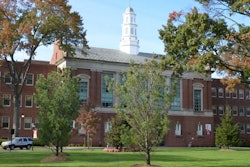The United States is taking a back seat to Japan, Korea and other global rivals when it comes to educating its citizens, according to a National Center for Public Policy and Higher Education report issued today. The report also finds that fast-rising college tuition is putting college out of reach for many would-be students.
“The report card’s findings challenge the notion that the American higher education system is still the best in the world,” says James B. Hunt Jr., chair of the center’s board of directors and former governor of North Carolina.
“In such key areas as college access and completion, the U.S. has made little or no progress, while other countries have made substantial gains,” Hunt says. “Our country must not remain satisfied with past achievements or reputation. We can and must mobilize our nation, our states and our colleges for success in this global competition.”
The study, titled “Measuring Up 2006: The National Report Card on Higher Education,” is the fourth in a series of national education report cards issued by the San Jose, Calif.-based center. The report finds that younger Americans are falling behind their counterparts in other nations when it comes to college enrollment and completion rates. The study finds that though the United States is still at the head of the pack in the proportion of its citizens aged 35 to 64 with a college degree, the country is only seventh on this measure among 25- to 34-year-olds.
The report finds that several nations have overtaken the United States when it comes to college access, and others are close behind. College completion rates in the United States also rank in the bottom half of the most recent international comparisons. Georgia is the highest ranking U.S. state in terms of degree completion, according to the report.
However, Dr. Laura M. Desimone, professor of public policy and education in the Department of Leadership, Policy and Organizations at Vanderbilt University, says the study’s comparisons between U.S. students and students abroad are erroneous.
“You have many systems — and it varies by country — where past ninth grade, and sometimes lower, there’s a very extreme sorting mechanism so that only the brightest or the most privileged students have access to the best schools, so you’re really not comparing apples to apples,” she says.
While the United States should do more to train students in hard science and mathematics, Desimone says the country should be applauded overall for its higher ed system.
“We provide incredible access to higher education in this country, both in our high school education system and in our higher education system, through community colleges, through second chances and through our state university systems — I think it’s important that we don’t lose sight of that,” she says.
However, the report echoes the concern of many that the soaring cost of higher education in the United States is shutting too many students out of the nation’s best schools.
“The nation’s colleges and universities have become less affordable for students and their families since the early 1990s. This year, no states received an ‘A’ or a ‘B’ in this category, and 43 states flunked, reflecting the deterioration of college affordability,” the report says.
The study finds that since the early 1990s, most states declined on college affordability measures, as the percentage of family income needed to pay net college costs at public four-year colleges increased dramatically. For instance, the average Ohio family has to dedicate 42 percent of family income to pay for a student’s college costs this year, compared to 28 percent in 1992. New Jersey went from 24 percent to 37 percent; and Iowa went from 18 percent to 30 percent.
“Perhaps [the] more distressing problem is, it’s not that we’re spending necessarily too little money on student aid, it’s that we’ve shifted to who we’re spending it on,” says Kati Haycock, director of the nonpartisan education advocacy group The Education Trust.
“In both private colleges and public four-year institutions, an increasing share of the dollars are going to students who have no demonstrated financial need whatsoever,” she says. “The results are clear. Four-year colleges are increasingly becoming bastions of the rich, and we have less generational economic mobility than at any time in the last 80-100 years.”
— By David Pluviose
|
Reader comments on this story: |
|
There are currently no reader comments on this story. |
© Copyright 2005 by DiverseEducation.com


















